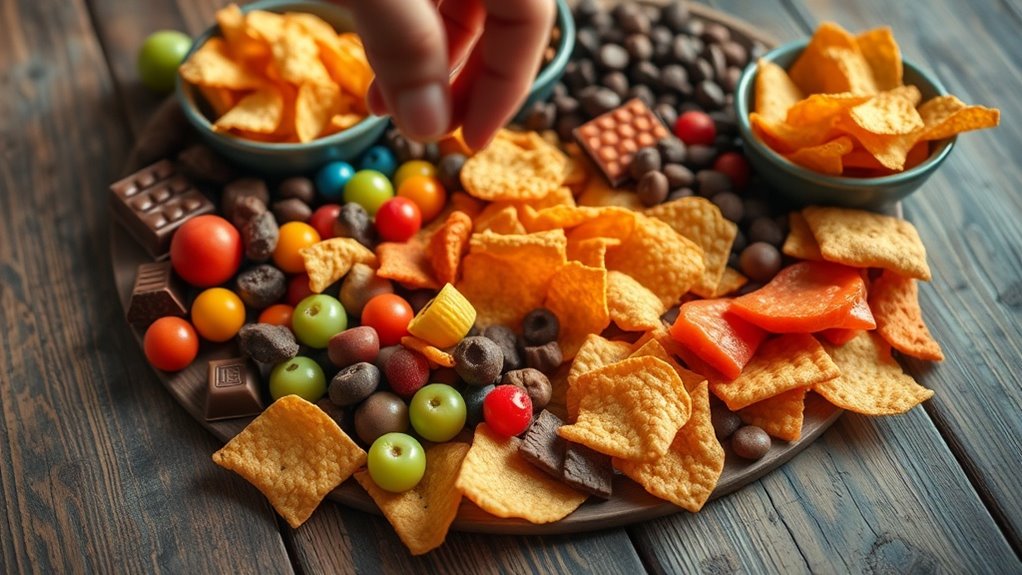Emotional Eating 101- What You Need to Know Before Your Next Snack
You’re probably familiar with the urge to snack when you’re stressed, bored, or feeling lonely. This is emotional eating—a common response to feelings rather than hunger. It’s important to identify your triggers and understand how they influence your food choices. Before you reach for that next snack, consider whether you’re truly hungry or just seeking comfort. What if there’s a better way to cope and foster a healthier relationship with food? Let’s explore that now.
Understanding Emotional Eating
Understanding emotional eating can empower you to address these feelings in healthier, more constructive ways without relying solely on food. It’s essential to recognize that many people experience hidden triggers that can unexpectedly prompt emotional eating, impacting their relationship with food.
Common Triggers of Emotional Eating
Many people find themselves reaching for food during specific emotional moments, often triggered by stress, boredom, or loneliness.
These feelings can lead you to seek comfort in snacks, turning to food as a quick fix.
Recognizing these triggers is essential; it allows you to address your emotions directly rather than masking them with unhealthy eating habits.
Awareness is the first step toward healthier choices. Additionally, understanding the psychological mechanisms behind stress eating can help you develop more effective coping strategies.
The Impact of Stress on Food Choices
When stress levels rise, it’s easy to turn to food as a source of comfort, often leading to less mindful choices. Stress can influence your cravings, making high-calorie, sugary, and fatty foods more appealing. Understanding these patterns may help you make better decisions during these moments. Additionally, choosing healthier options can mitigate feelings of stress, as certain foods have been shown to positively affect mental well-being.
| Stress Trigger | Food Choice |
|---|---|
| Work deadlines | Fast food or sugary snacks |
| Relationship issues | Ice cream or comfort foods |
| Financial worries | Processed snacks |
| Health concerns | High-calorie takeout |
| Social pressures | Sugary drinks or chips |
Mindful Eating Techniques
Mindful eating can transform your relationship with food by helping you focus on the present moment. By listening to your body’s hunger cues and slowing down your eating, you’ll make more intentional choices that nourish you. These techniques can empower you to break the cycle of emotional eating and enjoy your meals fully. Incorporating mindful eating habits into your daily routine can enhance your ability to savor food and recognize your true hunger and fullness levels.
Focus on the Present
Focusing on the present can transform your relationship with food, allowing you to savor each bite and recognize hunger signals without distraction.
When you eat mindfully, you engage your senses and create a deeper connection to your meals. This practice not only enhances enjoyment but also fosters awareness, helping you make informed choices that align with your emotional and physical needs.
Listen to Your Body
Listening to your body is key to developing a healthier relationship with food, as it encourages you to tune into your physical sensations and emotional cues.
Here are some mindful techniques to help you:
- Check in with hunger levels
- Notice cravings and their triggers
- Pay attention to fullness cues
- Identify emotional states
- Reflect on food choices
This awareness fosters a more intentional eating experience.
Slow Down Eating
Many people rush through meals, often finishing without even realizing it.
Slowing down can help you truly enjoy your food while promoting better digestion. Try taking smaller bites, chewing thoroughly, and putting your utensils down between bites.
These mindful eating techniques can help you recognize hunger cues and emotional triggers, fostering a healthier relationship with food and preventing overeating.
Developing Healthier Coping Mechanisms
To manage emotional eating, it’s important to establish healthier coping mechanisms that support your well-being. Mindful breathing can help anchor you in the present moment, while journaling your emotions allows for reflection and understanding. These strategies not only cultivate awareness but also empower you to respond to feelings in ways that don’t involve food. Additionally, practicing craving control techniques can further enhance your ability to manage urges effectively.
Mindful Breathing Techniques
While facing emotional cravings, you can harness mindful breathing techniques to cultivate healthier coping mechanisms.
Try these strategies:
- Focus on slow, deep breaths
- Count your inhales and exhales
- Visualize a calming scene
- Practice breathing through your nose and mouth
- Set aside a few minutes daily for this practice
These techniques can help you manage emotions without turning to food.
Journaling Emotions Regularly
Journaling emotions is a powerful tool for developing healthier coping mechanisms, especially when dealing with emotional eating.
By regularly recording your feelings, you can identify triggers and patterns, making it easier to address them without turning to food.
This reflective practice enhances self-awareness, fosters emotional regulation, and helps you develop more constructive responses to stress, ultimately leading to a healthier relationship with food.
Making Conscious Snack Choices
Sometimes, the snacks you choose can significantly impact your emotional well-being. Making conscious choices helps you maintain balance and mood stability. It’s essential to recognize true hunger versus cravings to make better snack decisions. Try these strategies:
- Opt for whole foods, like fruits and nuts
- Stay hydrated with water or herbal tea
- Prepare healthy snacks in advance
- Listen to your body’s hunger cues
- Manage portion sizes to avoid mindless eating
Your choices matter!




